

Statement of the problem: The bond strength of
PMMA to adhesive and non adhesive cements vary
and there is limited evidence on the bond strength
of cements to PMMA temporary crown and bridges.
Purpose: The purpose of this invitro study was to
evaluate the bond strength of PMMA crowns to
three temporary luting cements.
Materials and Methods: A total of 30 recently
extracted caries free mandibular second premolars
were selected and divided into three groups
according to luting cements used[Group 1: Zinc
Polycarboxylate cement (Polycem, Medicept);
Group 2 : Zinc Oxide Eugenol free luting cement
(Templute, Prime); Group 3 :Zinc Phosphate cement
(Adhesor, Spofa Dental)]. The tooth were mounted
on the clear acrylic rectangular blocks of size 8
mm x 8 mm x 20 mm dimensions according to
ISO 16506:201. Tooth preparations done and
provisional crowns were fabricated using heat
cure acrylic PMMA (DPI heat cure tooth moulding
powder). Then, these crowns were luted with three
temporary luting cements and the bond strength
were analysed using universal testing machine
(INSTRON 3345). Statistical analysis were done
using SPSS 26.0 and compared using one way ANOVA and Tukeys post Hoc test.
Results: The bond strength values of provisional
PMMA crown to three different temporary luting
cements were 6.37 MPa, 3.39 MPa and 4.40 MPa
(Zinc Polycarboxylate cement, Zinc Oxide Eugenol
free luting cement, Zinc Phosphate cement). One
way ANOVA shows significant difference in the
values among the groups (p<0.05) which shows
that zinc polycarboxylate provides better bond
strength compared with that of the zinc phosphate
and zinc oxide eugenol free luting cement to
PMMA temporary crowns. Tukeys Post Hoc test
for comparison between these groups shows no
significant difference in their values (p .00) which
shows high significant between the groups (p<0.05).
Conclusion: Within the limitations of this study,
Zinc Polycarboxylate provides better bond strength
followed by Zinc Phosphate and Non eugenol luting
cement to PMMA temporary crowns.
Clinical Implication: Zinc polycarboxylate is the
material of choice for luting long term provisional
PMMA crown
Key words: Zinc poly carboxylate, Zinc oxide eugenol free, Zinc phosphate, PMMA, Provisional restoration, Provisional luting cements
The key to the success of a provisional restorative
material depends on its ability to fulfill biological,
mechanical, and esthetic requirements until the
permanent restoration is luted1,2. PMMA is long
recognized as a reliable provisional restorative
material for FPD3,4. Use of long term provisional
acrylic FPDs are indicated in selected situations,
ranging from weeks to months as per the case
demands. Provisional restoration should serve
as a template for the final restorations and
should provide preview of the future prosthesis
by enhancing health of abutment and also
periodontium.5
Choosing an appropriate temporary cement also
depends on the following factors: how long the
temporary is needed, which type of tooth to which
the provisional is being cemented. The temporary
cement chosen must be easily removed and must
leave the tooth surface completely cleaned for
proper functioning of permanent restoration once
placed. Even microscopic remnants of temporary
cements interfere with bond of permanent
restoration.
Temporary cements with higher compressive
strength will withstand occlusal pressures, but will
make the temporary restoration harder to remove.
Here the bond strength of the luting agent becomes
more pertinent than in short term situations.
Zinc phosphate, polycarboxylate and zinc oxide
eugenol free were used in this study, because
these are the commonly used provisional luting
cements for cementation of provisional crowns in
routine clinical practice.
The bonding nature of PMMA to adhesive and
non adhesive cements can vary 5 and there is
limited evidence on the bond strength of cements
to PMMA temporary crown and bridges. Hence,
the study aims to evaluate the bond strength of
PMMA to three temporary luting cements. The null hypothesis is that there is no difference between
bond strength of three temporary luting cements
to PMMA resin.
A total of 30 recently extracted caries free
mandibular second premolars of approximately
same dimensions were selected. They were
cleansed by placing teeth in 1% hydrogen peroxide
solution for 24 hours. They were collected from
department of oral surgery. Then the roots of teeth
were incorporated in clear acrylic resin blocks
measuring 8 mm x 8 mm x 20 mm dimensions
according to ISO 16506:201(rectangular block).
The teeth were embedded in the acrylic block at a
level of 2 mm below the cemento-enamel junction.
After this, the mounted teeth were prepared
following the principles of tooth preparation, with
dental rotary instrument hand piece with diamond
bur (TR 12 ISO 199/016). All the dimensions were
predetermined to achieve the standardization
of the preparation. Flat occlusal reduction, 6°
convergences axially, chamfer finish line, height
of the crown 5 mm, buccolingual width 5 mm, and
mesiodistal width 4 mm6. These were analyzed
with digital parallelometer.
After tooth preparation, the aluminium foil was
used as a die spacer to obtain the film thickness
of the luting cement (25 µm). Then the wax patterns
were prepared over the aluminium foil of dimension 8 mm x 8 mm x 20 mm (rectangular block). The
patterns were then invested using a dental plaster
within the flask, dewaxed and packed with heat
cure PMMA (DPI heat cure tooth moulding powder)
and the provisional crowns were fabricated.
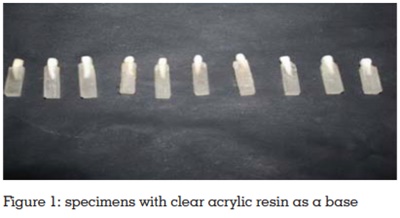
The provisional crowns were divided into three
groups based on temporary luting cements as
follows:
Group 1: PMMA resin crowns luted with zinc
polycarboxylate cement (Polycem, Medicept)
Group 2: PMMA resin crowns luted with zinc
oxide eugenol free luting cement (Templute, Prime)
Group 3: PMMA resin crowns luted with zinc
phosphate cement( Adhesor, Spofa dental).
Each group had 10 cemented provisional crowns,
therefore, making 30 cemented provisional crowns.
The cementation was done by single operator
using finger pressure. After cementation, it was
allowed to set for 24 hours at room temperature
for complete setting.
The tensile bond strength of three respective groups
were tested using universal testing machine with
cross head speed of 1 mm/min until debonding
within 500 N force (INSTRON 3345)6
and the datas
were collected.
The datas obtained were subjected to statistical
analysis using SPSS 26.0 and analyzed using
one way ANOVA for comparison of bond strength
with three different temporary luting cements and Tukeys post hoc test for comparison between these
groups at the significance level of (p<0.05)
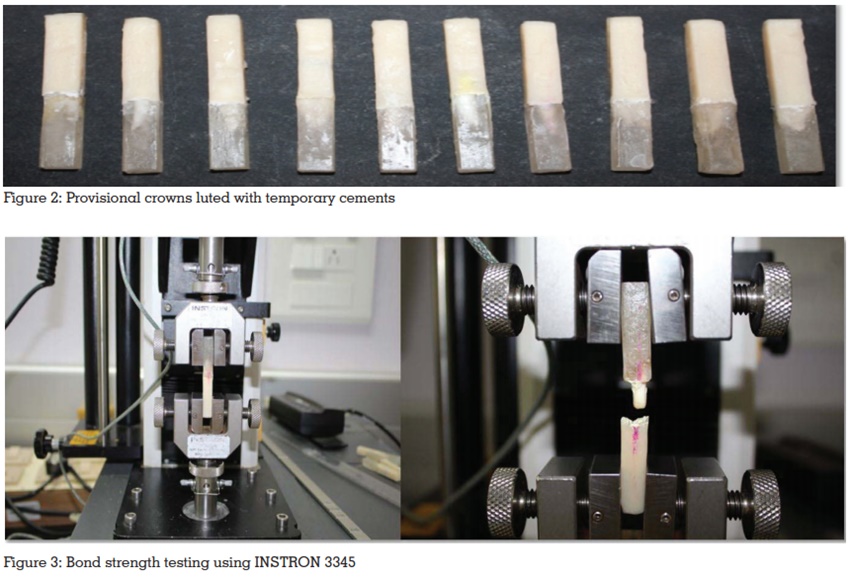
The bond strength values of provisional PMMA
crown to three different temporary luting cements
were 6.37 MPa (zinc polycarboxylate), 3.39 MPa (zinc
oxide eugenol free) and 4.40 MPa (zinc phosphate)
respectively. One way ANOVA shows significant
difference in the values among the groups (p<0.05)
which shows that zinc polycarboxylate provides
better bond strength compared with that of the zinc phosphate and zinc oxide eugenol free luting
cement to PMMA temporary crowns. Tukeys Post
Hoc test for comparison between these groups
shows no significant difference in their values (p
= .00) which shows high significant between the
groups (p<0.05).
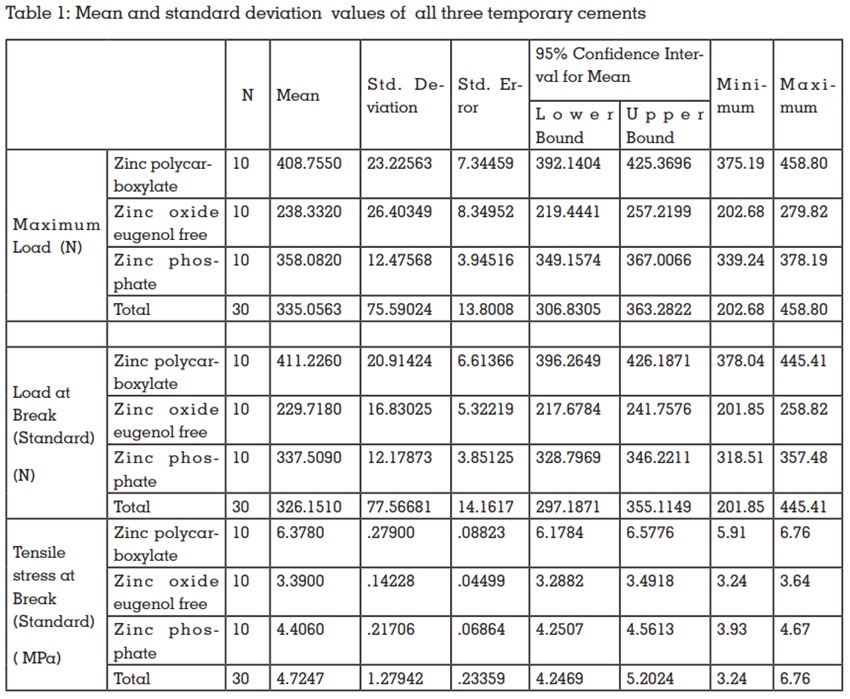
There is significant difference in the bond strength
of three luting cements to heat cure PMMA crowns,
hence null hypothesis is rejected.
This in vitro study is done in the natural teeth to
partly simulate the oral environment. There have
been many studies in the literature7,8 shows the
bond strength of luting cements to different core
materials, which is different from present study that
compared the luting cements to provisional PMMA
crown. These studies also does not simulate the
oral environment. There are no studies regarding
comparison of the bond strength of different
temporary cements to provisional PMMA crowns.
In the present study, zinc polycarboxylate provides
better bond strength compared with that of the
zinc phosphate and non eugenol luting cement
to PMMA temporary crowns. This result is similar
to Reddy et al9
and they reasoned that the
polycarboxylates have a higher adhesive strength
than zinc phosphate due to chemical reactions
where zinc ions cross link with adjacent poly acrylic
acid molecule. The poly acrylic acid molecules
have the ability to chelate to calcium ions in tooth
enamel as well as to stainless steel crown which
supports our study with increased bond strength of
zinc polycarboxylate to provisional PMMA crowns.
It also shows that adhesive cements provide better
bond strength due to its chemical adhesion to tooth structure compared with non adhesive cements.
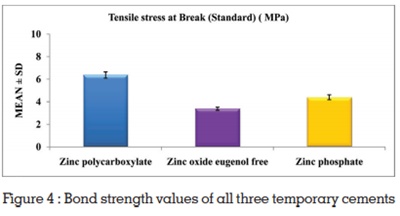
In the present study, zinc oxide eugenol free is
chosen in comparison with zinc oxide eugenol.
The reason is during resin polymerization can
be inhibited by any material that reacts with free
radicals. Eugenol is a free radical scavenger,
inhibiting polymerization either by a decrease
in the rate of initiation or an increase in the rate
of termination, which leads to increased surface
roughness, reduced micro hardness, and color
stability of resin composites cured in contact
with ZOE cement. Nasreen et al,10 in their study
reported that eugenol causes release of calcium
from dentin due to its complexing properties. This
may have a softening effect on dentin. Inadequate
polymerization coupled with softening of dentin leads to decreased bond strength and increased
microleakage, resulting in clinical complications,
such as fractured restoration, hypersensitivity,
secondary caries, and surface discoloration.
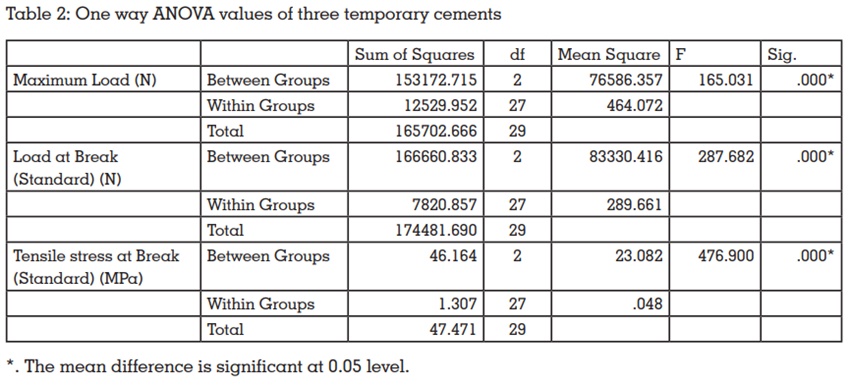
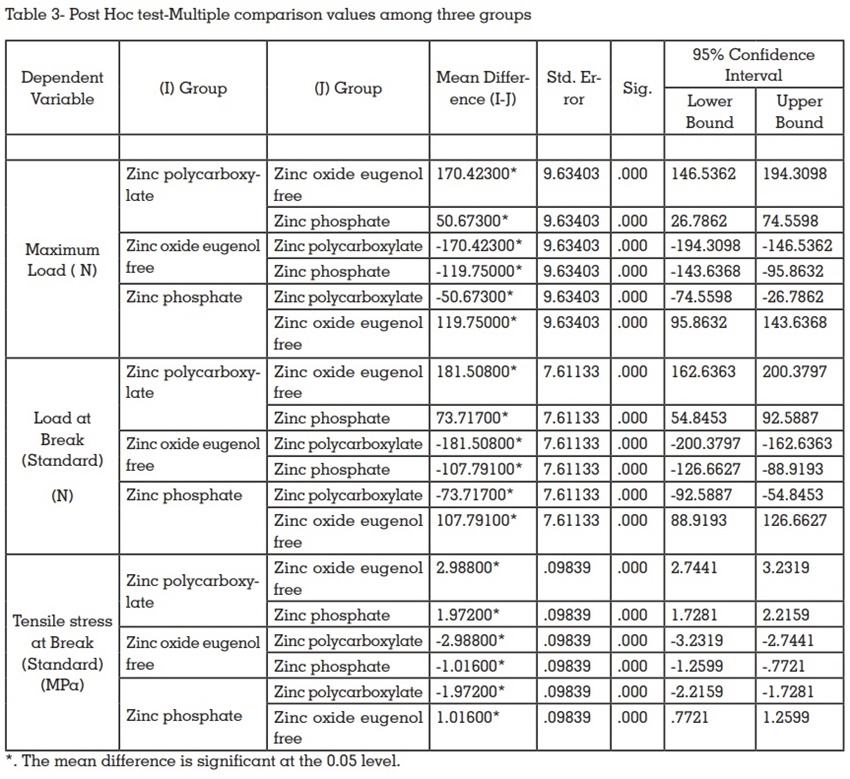
Within the limitations of this study, it is concluded that
Declaration of Competing Interest
The authors declare that they have no known
competing financial interests or personal
relationships that could have appeared to influence
the work reported in this paper.